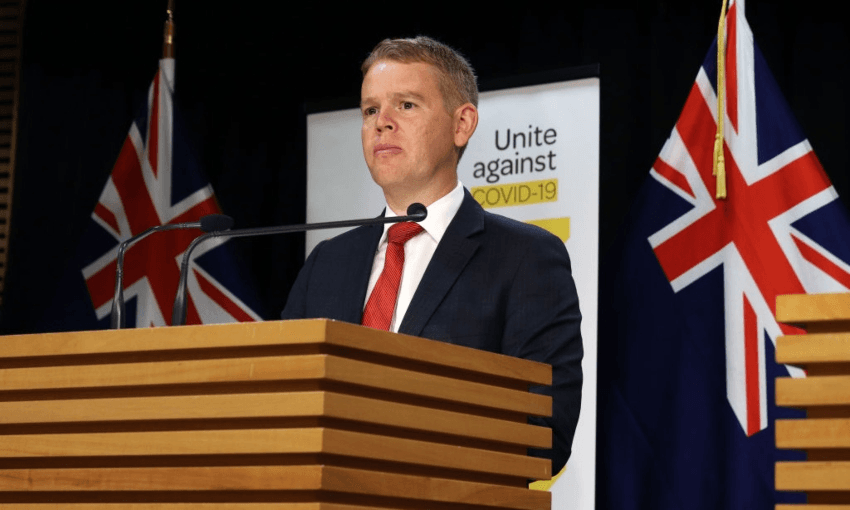The government has released few details about this country’s Covid-19 vaccine programme as it progresses. Overseas, meanwhile, countries are increasingly ambitious in their public goals to get jabs out. Justin Giovannetti reports.
New Zealand’s vaccine programme will move to its second stage next week as the families of border workers become eligible, but the government is staying silent about when most people will get a jab.
Distribution of Covid-19 vaccines around the world is speeding up as supply problems from earlier this year are overcome and new types of jabs are approved for use. Reflecting the increasing global supply, US president Joe Biden now says his country will have enough vaccines for its entire population by May.
New Zealand’s effort will roll out more slowly over the next year, Covid-19 response minister Chris Hipkins told reporters yesterday. “We can all feel that there is light at the end of the tunnel but the tunnel is quite a long one. We’re going to do this for some time before there is relief,” he said, warning of “hard yards over the next year”.
The country has yet to release any detailed roadmap for when most people will get a vaccine, something most of New Zealand’s traditional allies have done. While Australians, Canadians and Americans know where they stand in the queue for a jab, Hipkins said the government hasn’t finalised a plan yet. Once it does, it will release group-by-group who can receive a dose as part of a “rolling maul” over the next year.
“New Zealand’s population is different from other countries, so how we sequence things might be a little different,” said Hipkins. The country’s lack of significant community spread is another reason that a timeline hasn’t been released, he said.
The New Zealand government has also decided not to disclose when it expects vaccine shipments to arrive, citing contractual obligations with Pfizer. Some North American and European jurisdictions have released their expected allocations of vaccines from Pfizer and other suppliers weeks, sometimes months, into the future. New Zealand has so far only announced the delivery of vaccines after they have already arrived in Auckland.
As of yesterday, 9,431 people in New Zealand had received their first doses of the Pfizer vaccine. That’s about 0.2% of the population. Most of the people who have received a first jab work at the border, with nearly three-quarters in Auckland.
After all 12,000 in the border workforce are vaccinated – that includes all the staff at managed isolation and quarantine facilities, along with airport and maritime workers – the focus of the country’s programme will shift to their family members.
New Zealand’s third shipment of the Pfizer vaccine arrived on Tuesday and the country now has 200,000 doses. Once those doses are used up, expected in the next couple of months, about 2% of New Zealanders will have received both jabs necessary to make the vaccine fully effective.
That’s a low number by international standards.
More than half of Israelis have received a jab and the country has enough vaccine available to inoculate nearly its entire population with at least one dose. The country’s world-leading response has so far focused on seniors.
The UAE has enough jabs for over half its population, while about 16% of Americans have received one dose of the vaccine so far. The German response has been faced with mass public criticism for vaccinating only about 10% of its population.
Globally, doses have not been prioritised for either the worst-hit countries or the richest. Israel has enjoyed an uninterrupted supply, according to health officials there, and the country has been in talks with European nations about allowing them to access Israel’s supply of doses, which are being supplemented by local manufacturing.
According to Hipkins, New Zealand’s biggest challenge continues to be the flow of vaccines into the country, all of which arrive from facilities overseas. The Pfizer vaccine is the only jab approved for use in New Zealand. Some countries have already green-lit up to three different vaccines.
“One of the challenges that we want to manage carefully is that we don’t want to be in a position where we ramp up to the point where we can’t sustain the number of vaccines that we’re delivering and we have to then scale down again,” said Hipkins. “So we’ll be working carefully to make sure that we’re doing this in a sustainable way,” he added, explaining the lack of a publicly released roadmap for vaccines.
After border workers and their families are vaccinated, the government will move to non-border frontline health workers. That group, with nurses, ambulance workers, surgeons and GPs, is about 57,000 people. The government won’t specify yet when that group will be vaccinated, despite enough doses already being in the country to jab most of them.
There’s no shortage of groups that have asked or been suggested to come next after that. Some politicians have asked for South Auckland to be the focus of the programme, while associations representing meatpacking and aged care facilities have argued they should have priority.

